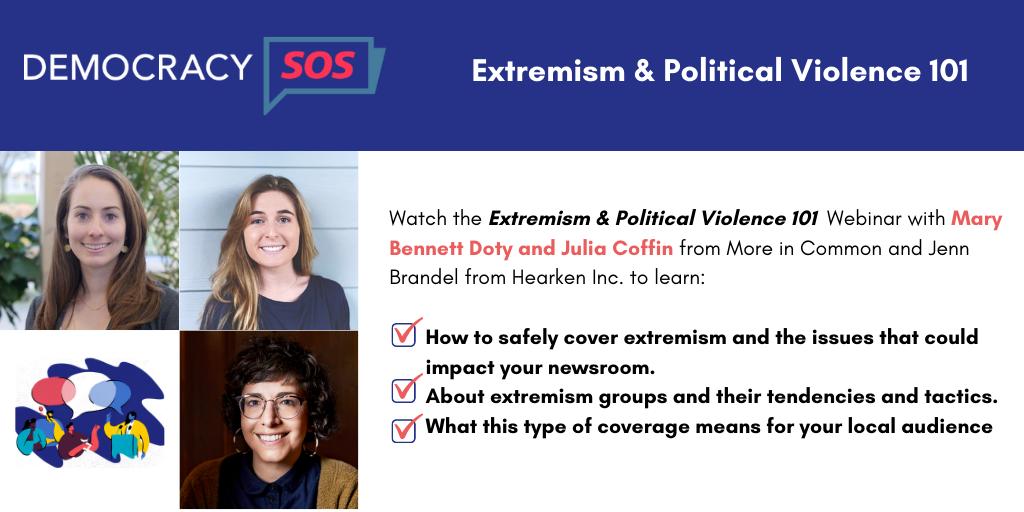
Scenario Planning for Political Violence
video
We hosted a training in late September about Extremism and Police Violence that featured two speakers from More in Common (MIC), a nonpartisan research nonprofit that works to counter polarization and social division, who shared insight into how newsrooms can mitigate fear and pessimism.
Here’s a recap of this training and scenario planning with some helpful takeaways.
MIC’s Julia Coffin offered an overview of key drivers of political violence, and how violence could manifest during elections, and how journalists can challenge disinformation and equip their audiences to engage in healthy democratic practices. MIC’s Mary Bennet shared key trends observed by partner organizations.
Key context:
- Trust in major US institutions such as the media and Congress is on a decline.
- Political violence has spiked in the wake of the Trump presidency.
- Militias with extremist ties have ramped up recruitment and presence at political gatherings.
- Activity by the likes of the right wing armed militia the Proud Boys rose by 15%, and increased engagement in violence rose by over 50%, according to reports.
- A leaked armed militia membership roll includes the names of over 370 US law enforcement officials, military members and politicians or candidates
- There’s a critical shortage of poll-workers across the country, driven in part, by the rising threats of intimidation and violence directed at election personnel that have countered the “Big Lie,” the baseless conspiracy theory that the 2020 election was stolen from Donald Trump.
- There’s a growing number of credible threats against election officials, politicians, journalists and academics who challenge the Big Lie.
- According to the Brennan Center for Justice, 19 states have passed 34 restrictive voting measures this year , and especially since the 2020 election, targeting immigrant, student and BIPOC populations (The Supreme Court has also struck down several key voting rights protections over the past two decades). On the flip 25 states have passed laws expanding voting access.
Key definitions:
Political violence: violence aimed at political ends and relates to the controlling or changing of the benefactors and participators in political, economic and socio-cultural life.
Electoral violence: a form of political violence is any harm, or threat of harm to person or property involved in the election process.
SCENARIO PLANNING ACTIVITY
Participants engaged in a scenario planning exercise to help them think about the election and political violence that may unfold during the midterms, and what they should be doing now to prepare. Scenario planning is a useful team for newsrooms to think through what relationships they should be building, stories they should work on, and what disinformation they can challenge and “pre-bunk.”
The exercise walked participants through how political violence might unfold in Georgia in the build-up and immediately following the midterm election. For a copy of the scenario planning activity, please reach out to julia@moreincommon.com.
DISCUSSION QUESTIONS
We broke up into small groups to discuss the scenario and the following three questions.
- What information should you learn now to be able to accurately and holistically report on the results in your state?
- Who are your sources of expertise?
- What articles should you write between now and November 8 to help illuminate critical tension points, debunk myths, build trust in our democracy or set expectations on election day?
Best Practices/Takeaways:
- Build relationships early with voting experts and election administrators now; don’t expect you will be able to cold call them on the night of a highly contentious election.
- Become an expert in how elections are administered in your state so you can share that information with the public, as well as spot related misinformation. Things to know:
- Rights and responsibilities of poll watchers
- Who are the top 5 extremists operating in your area and what are they saying / doing?
- Who gets to call the vote?
- What authority do different bodies have?
- What are the voter ID laws?
- What are the Militia laws?
- When to expect votes to be counted and final?
- Share with the public what voter intimidation is, what to do if they are facing intimidation, what the law is and how to report and document intimidation.
- Pre-bunk conspiracy theories, educate your audience on how the election system works to help immunize them from disinformation.
- Prioritize coverage that is proportional to the threats.
- If violence does occur, make sure you contextualize how rare or commonplace it was. That is, if only one polling place out of 100 had an issue, make sure your reporting acknowledges that so people do not believe a problem is worse than it was.
- Know who the community and bridging organizations are in your community: these may be community centers, mediation centers, cultural centers. They may activate to support the community during or after violence.
- Invest in building strong relationships and trust with communities that are directly impacted by violence or restrictive voting laws.
We recommend every newsroom sets aside an hour to scenario plan for if elections become violent, and make a plan for the possibilities therein. Check out Election SOS’s 2020 Scenario Planning Guide for practical information and support, as well as the toolkit on covering conflict.
More In Common
More in Common is a nonpartisan research and audience-centric nonprofit that works to build societies and communities that are stronger, more united, and more resilient to the increasing threats of polarization and social division.
Learn more by visiting their website: https://www.moreincommon.com/
Next Steps
